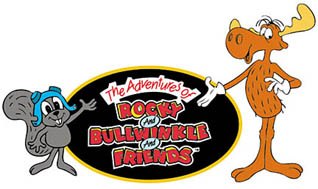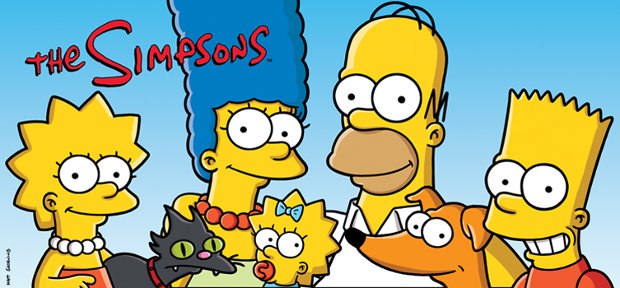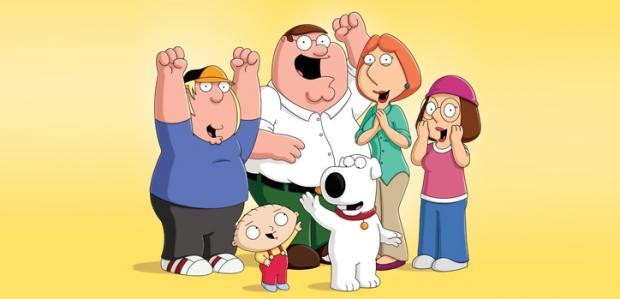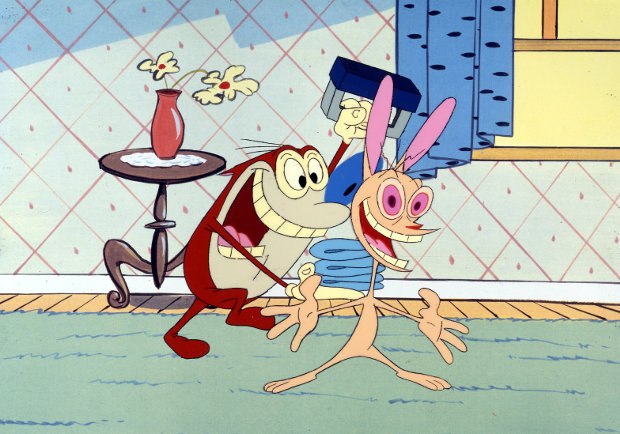What does “Postmodern” really mean in terms of animation? Dr. Toon takes a look at an overused term.
In a medium as wonderfully variegated as animation, one hates to deal in generalities. There’s simply too much individuality sprinkled in among the assembly-line mentality and the detachment of overseas production that plagues television animation today. Yet, every time a cartoon pokes a bit past the edges of conventionality, some critic slaps the term “postmodern” on it. Indeed, the term is rapidly becoming amorphous, a catchphrase signifying nothing.
Postmodernism does not predate animation. It dates back only as far as the late 1970s, the conceptual masterwork of philosopher Jean-François Lyotard. There is considerable academic dickering on what constitutes the postmodern, as it can apply to artistic, cultural, or economic definitions. Definitions of Postmodernism convey more sense if it is seen as a movement with somewhat defined tenets.
Modernist thought is supposed to represent the primacy of objective knowledge and the unity of that knowledge with reason; Modernism is optimistic in nature and allies itself with notions of progress. Knowledge is sharply defined and with an assumption of certainty There is a unified perspective of truth, resulting in what the Modernist mind called “The Grand Narrative”, or “meta-narrative”, with reason an science providing dependable answers to, well, everything.
Postmodernism calls all of this into question. Its most definitive characteristic is the questioning of any Grand Narrative, order, or rational, scientific explanations for anything. It appears in retrogressive art forms, thrives on irony and parody, and realizes itself in the practice of extreme self-reflexivity. There is a general breakdown between high and low cultural standards and forms, and disorientation, rather than certainty, is the order of the day. Finally, Postmodernism accepts the notion of “secondary orality”, in which information is totally conveyed by visual and aural means, as written literacy breaks down as a form of communication. From there it’s a short hop to deconstruction, where a text is seen to have no author and is only interpretable according to the individual reader.
Thanks a lot, Dr. Toon. Now tell us how this relates to animation criticism and why is it important to know. Simple, dear readers. You want to avoid being misled, misleading others, and you always want to keep your criticism honest and correct. Also…um…it’s important to know exactly what you’re talking about when you present your ideas to a readership.
The problem with postmodern interpretation, you see, is that postmodernity has been a coherent concept since, oh, 1979. What, indeed, did analysts call The Rocky and Bullwinkle Show (later called The Bullwinkle Show) back in the days from 1959-1964? The adventures of moose and squirrel, along with its accompanying short features such as Fractured Fairy Tales, met every current criterion for postmodernity. Where are retrospective analyses and academic studies on The Bullwinkle Show today?
If we are to identify postmodernism in animation, we must apply the rules rather stringently. It is possible for a given cartoon to meet one or two of the criteria above and still not qualify. This mostly happens when the work in question is derivative of true postmodernity, or is simply presenting itself as trendy and cool.
The animated series most often tagged as “postmodern” is The Simpsons. If you care to combine the search terms and send Google on its happy way, you will come across countless references and quite a few scholarly texts that have indecipherable content relating to intertextuality, semiotics, Marxism, and other marginally entertaining nonsense. It is highly fashionable to label this series as “postmodern”, but is that really the truth?
I’m going to argue against legions of deconstruction-obsessed scholars and pedantic media analysts and present why I believe it is not. Then we’ll take a look at a series that truly earned the title.
To begin with, The Simpsons is actually a satirical sitcom. It takes place inside a meta-narrative. Springfield exists with a defined set of citizens and families, recurring characters that inhabit an established universe. There are schools, homes, recognizable businesses and work environments. The focus is usually on a single family of yellow humanoids, but their being so does not make them postmodern, any more than animated talking animals are.
There is nothing particularly retrogressive about the cartoon. It apparently takes place in modern times, with modern technology and media extant. The family Simpson exists in a single time and place, and their roles generally do not vary. Although Homer may meet celebrities or be replaced on the company softball team by Darryl Strawberry, he remains Homer Simpson. Although there are definite (and invariably hilarious) instances of self-reflexivity in the show, there is also considerable consistency. Maude Flanders died and never returned, Sideshow Bob remains unrepentantly evil, and Homer still works for Mr. Burns. Even the surprises are no surprise: As social critic Mark Dery explains, the paradoxical clown embodied by Krusty is a common social archetype.
The Simpsons, in factis not half as obsessed with obscure in-jokes as its weaker clone, Family Guy (which may be slightly more “postmodern” in that regard). The Simpson’s universe does not truly upset the established order; they are a clever, and for the most part, gentle parody of it. The dreary parade of academic papers extolling arcane Marxist interpretations of the show are, in the end, as useless as broken skateboard wheels would be to Bart Simpson. While the show can be subjectively enjoyed and interpreted, it is presented in a coherent and objective manner, that of an off-kilter family sitcom.
Then we have The Ren and Stimpy Show. This is probably the best example of a postmodern cartoon to date. Before looking at a single frame of the show, however, it’s important to observe that Ren and Stimpy were the work of a postmodern creator. John Kricfalusi had no use for a grand narrative. He was concerned mostly with what was funny, cartoonish, and unordinary. His show had no cohesive narrative, even with recurring characters extant.
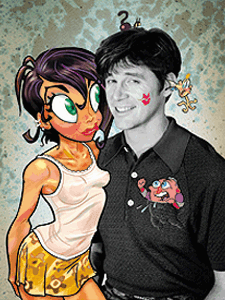
John K. was not of the established order. In opposition to the standard network method of production, his preferred method of filmmaking was the creator-driven cartoon, in which all power and decision-making was centralized in the originator. Rather than work from scripts, John K preferred to construct his work in the storyboard and layout stages. If these preferences resulted in missed air dates, longer gestation periods of production, or the disappointment of fandom, that was simply a price to be paid for producing a quality vision.
Ren and Stimpy, for this reason, met the qualifications of being retro, since John K. emulated the production methods of cartoons during the theatrical era. The characters themselves, with their physical and emotional distortions, were rooted in the tradition of Warner Bros. director Bob Clampett, who hit his greatest stride in the 1940s. John K. was a fan and colleague of Ed Benedict, who graduated from the Tex Avery unit at MGM to Hanna-Barbera fifty-four years ago. Once there, he contributed to the look of H-B’s earliest characters.
The psychotic Chihuahua and his brainless sidekick repudiate meta-narrative as much as their creator did. Their roles varied from Fire Dogs to Rubber Nipple Salesmen to space cadets, and that’s only a small sample. They never seemed to reside in the same domicile. Their sexual preferences, until late in the series, were uncertain. Once they were revealed as a gay couple, they further upset the established order. Parody showed up often in the series, from the faux-ads for “Log” (with retrogressive, Hubley-esque designs) to the resident superhero, Powdered Toast Man.
A breakdown between high and low cultural forms? John K. employed classical music in many episodes, even as Stimpy was hugging his litter box. Ren and Stimpy could be a very disorienting cartoon. The characters survived, with no apparent long-term damage, disembowelments, diseases, injuries, flayings, and bodily insults that would have been totally out of place on The Simpsons.
Ren is being self-reflexive when he refers to cartoons as “puppets” and avers that they will rot Stimpy’s brain. Other recurring characters, especially George Liquor and Mr. Horse, are in-jokes whom are used to play different roles on the show.
In the final analysis, The Ren and Stimpy Show meets the requirements of postmodernity, whereas it’s harder to make a case for The Simpsons, who are touted as the ne plus ultra of the concept.
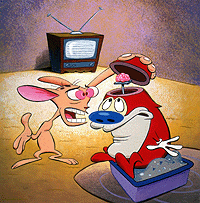
Of course, a dedicated postmodernist would argue that both cartoons are equally postmodern. The deconstructionists are somewhat masters of eating their cake and having it too, since any given text, piece of art, or social construct can mean anything they wish it to mean. There are, after all, no authors. Here, Derrida, Barthes, Eco, and their ilk become an ouroborus, the snake that devours its own tail. “A work is postmodern because I interpret it that way which makes it postmodern because I interpret it that way…” ad infinitum.
Such canting nonsense lays traps for critics with integrity, who actually hold the postmodernists to their slippery and facile words. When you hear trendy but shallow analysts make generalizations about any piece of animation, tossing about the word “postmodern” without discerning it’s meaning, you know that you are in the presence of those schooled only in keywords.
If there has been one consistent thread to the “Animation Critics Art” series, it is this: Educate yourselves, then think for yourselves. You will survive the consequences and be all the better for it. As will your readers.
--
Martin "Dr. Toon" Goodman is a longtime student and fan of animation. He lives in Anderson, Indiana.
